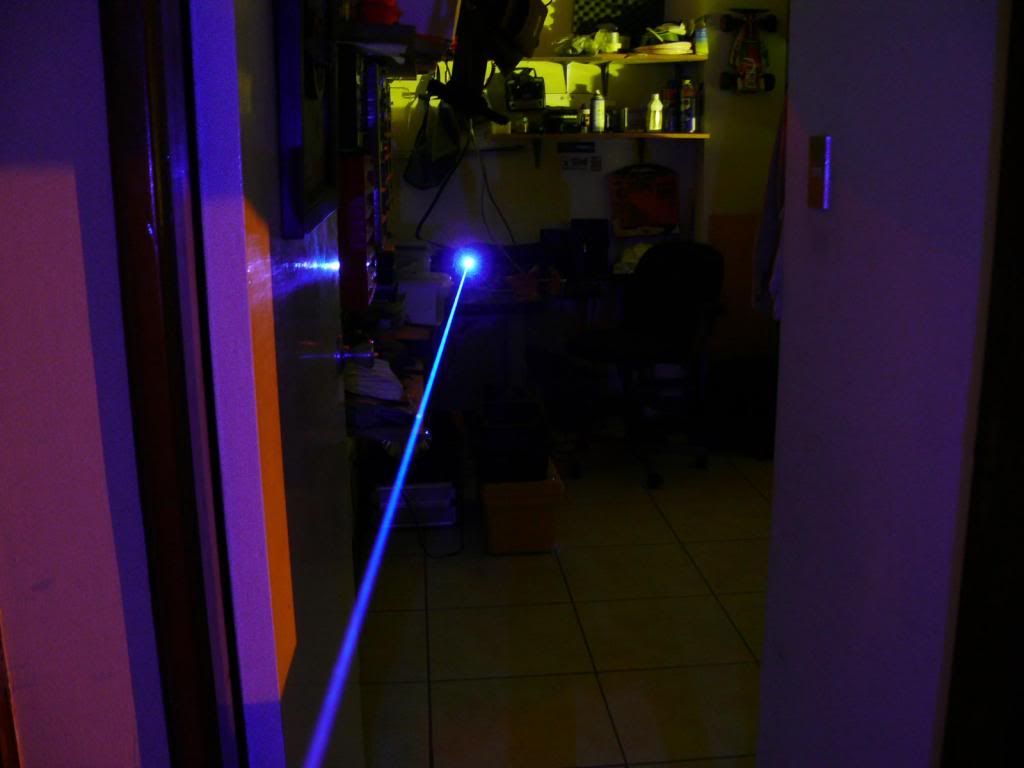IsaacT
0
- Joined
- Aug 25, 2010
- Messages
- 5,950
- Points
- 83
THE WAVELENGTH POKEDEX!!!!!!! A Resource for Enthusiasts!
This is meant to be a resource for those seeking data or color reference on different laser wavelengths. Encyclopedia will be separated into two parts. The first post will be Diode Lasers, Diode Pumped Solid State(DPSS) Lasers, and Sum Frequency Generation(SFG) Lasers. The second post will contain gas lasers. Wavelengths covered will be limited to those in the visible spectrum of light.
If you have data, descriptions, or pictures of the wavelengths listed, you may PM me with it and I will see about adding it here. All contributions to the information gathered here will be credited.
All section titles will have specific font coloring appropriate to their wavelength, acquired through THIS wavelength to HEX converter tool created by RHD ages ago. (Hint: this is great for customizing you signatures with as well)
-------------------------------------------------------------------------------------------------------------------------------------------------------------------------------------------------------------------------
-------------------------------------------------------------------------------------------------------------------------------------------------------------------------------------------------------------------------
405nm LASER Light
Process: Diode Laser | InGaN Semiconductor
Descriptions:
"This wavelength really carries a royal luster reminiscent of Amethysts. Especially when the beam is illuminated through the use of fog or visualizer, the beam has a richness about it which is enthralling. Difficult to view at long distances due to its tendency to cause fluorescence in the eye, viewers will note it becomes blurry and difficult to manually focus after a short distance." - Wannaburnstuff
Pictures: is difficult to capture, the circled purple section is what it appears as to me.
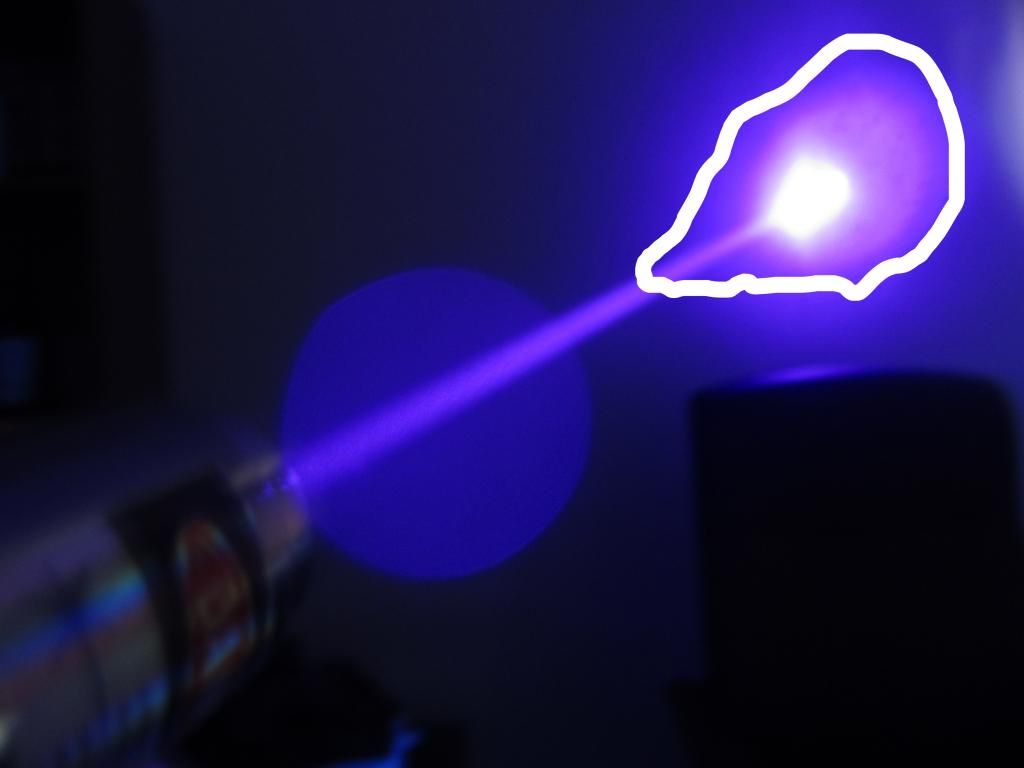
-------------------------------------------------------------------------------------------------------------------------------------------------------------------------------------------------------------------------
445nm/450nm LASER Light
Process: Diode Laser | InGaN Semiconductor
Descriptions:
"This wavelength, despite becoming more and more common amongst hobbyists, will always hold a place in my heart(or eyes) for its spectacular blue color. Many describe it as being an indigo, sort of truck stop between the more exotic blues and the more common 405nm lasers. To go back to the gemstone descriptors, I would compare this wavelength to a deep sapphire. Definitely blue, but with a darker hue. This color wavelength always makes me think of magic, and I admit to using my low powered 450nm laser as a wand, shooting beams of magic into a mirror." - Wannaburnstuff
Pictures:

Picture courtesy of ZRaffleticket
-------------------------------------------------------------------------------------------------------------------------------------------------------------------------------------------------------------------------
473nm LASER Light
Process: DPSS | An 808nm Diode is used to pump an Nd:YAG crystal to lase at 946nm wavelength. This light is then frequency doubled to 473nm light by passing through a BBO or LBO crystal. Low efficiency at around 5%.
Descriptions:
Pictures: This Picture by member Eudaimonium. Pictured is RPL-473(left) and a 445nm Laser(Right).

Picture Courtesy of Eudaimonium

Picture Courtesy of ZRaffleticket
-------------------------------------------------------------------------------------------------------------------------------------------------------------------------------------------------------------------------
510nm LASER Light
Process: Diode | Need Information on Semiconductor
Descriptions:
Pictures:
-------------------------------------------------------------------------------------------------------------------------------------------------------------------------------------------------------------------------
520nm LASER Light
Process: Diode | Need Information on Semiconductor
Descriptions:
"This wavelength is a much purer green than 532nm lasers we have come to know and love. It is a very lovely green color, lacking much of the sharpness 532's yellow tinge brings to the table. This creates a nice, subtle green. It reminds me of the green lantern often, and if I were to compare it to a gemstone I would compare it to an emerald sitting on a light. It makes me think of tree leaves and grass a lot." - Wannaburnstuff
Pictures:
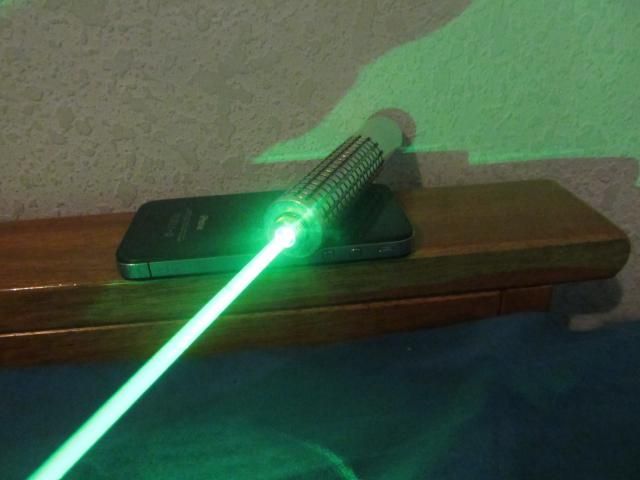
Picture Courtesy of Wannaburnstuff

Picture Courtesy of Wannaburnstuff

Picture Courtesy of ZRaffleticket
-------------------------------------------------------------------------------------------------------------------------------------------------------------------------------------------------------------------------
532nm LASER Light
Process: DPSS | An 808nm Diode is used to pump Nd:YAG or Nd:YVO4 crystal to lase at 1064nm. This light is frequency doubled to 532nm light by passing through KTP crystal. This process is 20-35% efficient.
Descriptions:
"This is one of those wavelengths that strikes me as very neon-esque in that the color seems quite electric in tone. A mixture of green and some small amount of yellow, this wavelength is becoming more and more common. Due to its beam characteristics, I often imagine this wavelength as a thin thread of energy. Gemstone comparison for this wavelength would have to be Peridot." - Wannaburnstuff
Pictures:
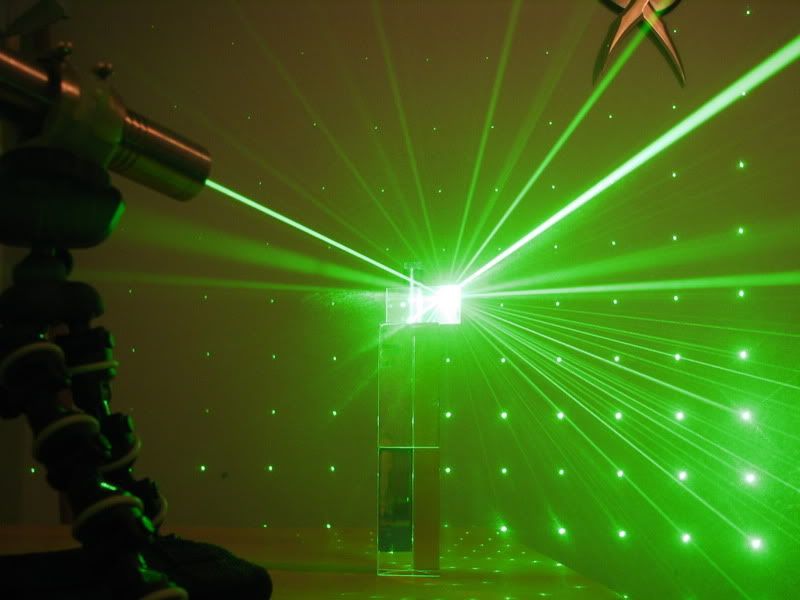
Picture Courtesy of Wannaburnstuff

Picture Courtesy of ZRaffleticket
-------------------------------------------------------------------------------------------------------------------------------------------------------------------------------------------------------------------------
561nm LASER Light
Process: DPSS | An 808nm Diode is used to pump an Nd:YAG crystal to lase at 1110nm. This light is frequency doubled by passing through an LBO crystal. Efficiency is higher, at ~20%.
Descriptions:
Pictures:

Picture Courtesy of Arynthya

Picture Courtesy of Arynthya
-------------------------------------------------------------------------------------------------------------------------------------------------------------------------------------------------------------------------
589nm LASER Light
Process: Sum Frequency Generation | An 808nm Diode is used to pump an Nd:YAG crystal to laser at both 1064nm and 1319nm light. These lines are converted to 589nm light via SFG.
Descriptions:
Pictures:

Picture Courtesy of ZRaffleticket
-------------------------------------------------------------------------------------------------------------------------------------------------------------------------------------------------------------------------
593.5nm LASER Light
Process: Sum Frequency Generation | Similar to 589, an 808nm Diode is used to pump an Nd:YVO4 crystal to lase at both 1064nm and 1342nm light. These lines are converted to 593.5nm light via SFG.
Descriptions:
"This wavelength is such a warm yellow color, and reminds me of a liquid fire. If a dragon were to breathe, this is what color his breath would be. Rather than compare it to a gemstone, I would say it reminds me of pure gold." - Wannaburnstuff
Pictures:
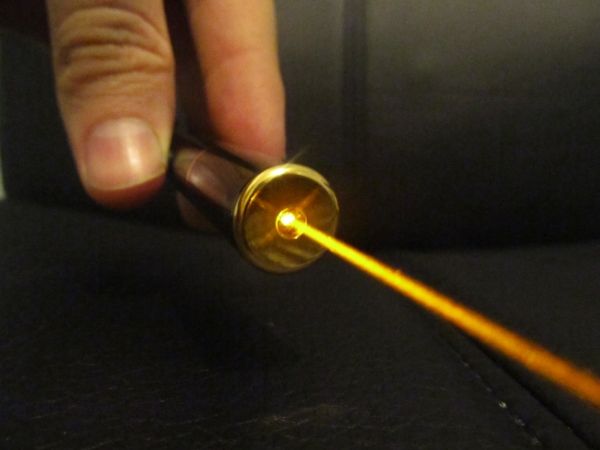
Picture Courtesy of Wannaburnstuff
-------------------------------------------------------------------------------------------------------------------------------------------------------------------------------------------------------------------------
635nm/638nm LASER Light
Process: Diode | AlGalnP Semiconductor
Description
"This wavelength is very vibrant and similar to 650nm until they are viewed side by side. Somewhat reminiscent of the Ruby gemstone, this is the closest to Orange many hobbyits ever get due to the costs inherent in going lower." - Wannaburnstuff
Pictures:

Picture Courtesy of ZRaffleticket
-------------------------------------------------------------------------------------------------------------------------------------------------------------------------------------------------------------------------
650nm/660nm LASER Light
Process: Diode | AlGalnP Semiconductor
Descriptions:
"These wavelengths get mixed up and thrown together so much that I don't really differentiate anymore. This color is a darker, blood red reminiscent of Garnet." - Wannaburnstuff
Pictures:

Picture Courtesy of ZRaffleticket
-------------------------------------------------------------------------------------------------------------------------------------------------------------------------------------------------------------------------
671nm LASER Light
Process: DPSS | 808nm Diode is used to pump an Nd:YAG or Nd:YVO4 crystal to lase at 1342nm light. This light is frequency doubled to 671nm Light by passing through nonlinear optics, probably LBO crystal.
Descriptions:
Pictures:

Picture Courtesy of Arynthya

Picture Courtesy of Arynthya
-------------------------------------------------------------------------------------------------------------------------------------------------------------------------------------------------------------------------
-------------------------------------------------------------------------------------------------------------------------------------------------------------------------------------------------------------------------
I hope everyone enjoys this thread and I hope it is helpful to those considering purchases. I know being able to see what things should look like helps me to decide ESPECIALLY when I am going back and forth between two or more options. Thanks to ZRaffleticket for clearing up some questions I had about the materials used for some of the DPSS processes!
Thanks,
Isaac
This is meant to be a resource for those seeking data or color reference on different laser wavelengths. Encyclopedia will be separated into two parts. The first post will be Diode Lasers, Diode Pumped Solid State(DPSS) Lasers, and Sum Frequency Generation(SFG) Lasers. The second post will contain gas lasers. Wavelengths covered will be limited to those in the visible spectrum of light.
Each entry will proceed as follows:
WAVELENGTH NAME
Process: Type | Full Process
Descriptions: Word descriptions of the wavelengths by members
Pictures: Pictures of the wavelengths by members
If you have data, descriptions, or pictures of the wavelengths listed, you may PM me with it and I will see about adding it here. All contributions to the information gathered here will be credited.
All section titles will have specific font coloring appropriate to their wavelength, acquired through THIS wavelength to HEX converter tool created by RHD ages ago. (Hint: this is great for customizing you signatures with as well)
-------------------------------------------------------------------------------------------------------------------------------------------------------------------------------------------------------------------------
-------------------------------------------------------------------------------------------------------------------------------------------------------------------------------------------------------------------------
405nm LASER Light
Process: Diode Laser | InGaN Semiconductor
Descriptions:
"This wavelength really carries a royal luster reminiscent of Amethysts. Especially when the beam is illuminated through the use of fog or visualizer, the beam has a richness about it which is enthralling. Difficult to view at long distances due to its tendency to cause fluorescence in the eye, viewers will note it becomes blurry and difficult to manually focus after a short distance." - Wannaburnstuff
Pictures: is difficult to capture, the circled purple section is what it appears as to me.

-------------------------------------------------------------------------------------------------------------------------------------------------------------------------------------------------------------------------
445nm/450nm LASER Light
Process: Diode Laser | InGaN Semiconductor
Descriptions:
"This wavelength, despite becoming more and more common amongst hobbyists, will always hold a place in my heart(or eyes) for its spectacular blue color. Many describe it as being an indigo, sort of truck stop between the more exotic blues and the more common 405nm lasers. To go back to the gemstone descriptors, I would compare this wavelength to a deep sapphire. Definitely blue, but with a darker hue. This color wavelength always makes me think of magic, and I admit to using my low powered 450nm laser as a wand, shooting beams of magic into a mirror." - Wannaburnstuff
Pictures:

Picture courtesy of ZRaffleticket
-------------------------------------------------------------------------------------------------------------------------------------------------------------------------------------------------------------------------
473nm LASER Light
Process: DPSS | An 808nm Diode is used to pump an Nd:YAG crystal to lase at 946nm wavelength. This light is then frequency doubled to 473nm light by passing through a BBO or LBO crystal. Low efficiency at around 5%.
Descriptions:
Pictures: This Picture by member Eudaimonium. Pictured is RPL-473(left) and a 445nm Laser(Right).

Picture Courtesy of Eudaimonium

Picture Courtesy of ZRaffleticket
-------------------------------------------------------------------------------------------------------------------------------------------------------------------------------------------------------------------------
510nm LASER Light
Process: Diode | Need Information on Semiconductor
Descriptions:
Pictures:
-------------------------------------------------------------------------------------------------------------------------------------------------------------------------------------------------------------------------
520nm LASER Light
Process: Diode | Need Information on Semiconductor
Descriptions:
"This wavelength is a much purer green than 532nm lasers we have come to know and love. It is a very lovely green color, lacking much of the sharpness 532's yellow tinge brings to the table. This creates a nice, subtle green. It reminds me of the green lantern often, and if I were to compare it to a gemstone I would compare it to an emerald sitting on a light. It makes me think of tree leaves and grass a lot." - Wannaburnstuff
Pictures:

Picture Courtesy of Wannaburnstuff

Picture Courtesy of Wannaburnstuff

Picture Courtesy of ZRaffleticket
-------------------------------------------------------------------------------------------------------------------------------------------------------------------------------------------------------------------------
532nm LASER Light
Process: DPSS | An 808nm Diode is used to pump Nd:YAG or Nd:YVO4 crystal to lase at 1064nm. This light is frequency doubled to 532nm light by passing through KTP crystal. This process is 20-35% efficient.
Descriptions:
"This is one of those wavelengths that strikes me as very neon-esque in that the color seems quite electric in tone. A mixture of green and some small amount of yellow, this wavelength is becoming more and more common. Due to its beam characteristics, I often imagine this wavelength as a thin thread of energy. Gemstone comparison for this wavelength would have to be Peridot." - Wannaburnstuff
Pictures:

Picture Courtesy of Wannaburnstuff

Picture Courtesy of ZRaffleticket
-------------------------------------------------------------------------------------------------------------------------------------------------------------------------------------------------------------------------
561nm LASER Light
Process: DPSS | An 808nm Diode is used to pump an Nd:YAG crystal to lase at 1110nm. This light is frequency doubled by passing through an LBO crystal. Efficiency is higher, at ~20%.
Descriptions:
Pictures:

Picture Courtesy of Arynthya

Picture Courtesy of Arynthya
-------------------------------------------------------------------------------------------------------------------------------------------------------------------------------------------------------------------------
589nm LASER Light
Process: Sum Frequency Generation | An 808nm Diode is used to pump an Nd:YAG crystal to laser at both 1064nm and 1319nm light. These lines are converted to 589nm light via SFG.
Descriptions:
Pictures:

Picture Courtesy of ZRaffleticket
-------------------------------------------------------------------------------------------------------------------------------------------------------------------------------------------------------------------------
593.5nm LASER Light
Process: Sum Frequency Generation | Similar to 589, an 808nm Diode is used to pump an Nd:YVO4 crystal to lase at both 1064nm and 1342nm light. These lines are converted to 593.5nm light via SFG.
Descriptions:
"This wavelength is such a warm yellow color, and reminds me of a liquid fire. If a dragon were to breathe, this is what color his breath would be. Rather than compare it to a gemstone, I would say it reminds me of pure gold." - Wannaburnstuff
Pictures:

Picture Courtesy of Wannaburnstuff
-------------------------------------------------------------------------------------------------------------------------------------------------------------------------------------------------------------------------
635nm/638nm LASER Light
Process: Diode | AlGalnP Semiconductor
Description
"This wavelength is very vibrant and similar to 650nm until they are viewed side by side. Somewhat reminiscent of the Ruby gemstone, this is the closest to Orange many hobbyits ever get due to the costs inherent in going lower." - Wannaburnstuff
Pictures:

Picture Courtesy of ZRaffleticket
-------------------------------------------------------------------------------------------------------------------------------------------------------------------------------------------------------------------------
650nm/660nm LASER Light
Process: Diode | AlGalnP Semiconductor
Descriptions:
"These wavelengths get mixed up and thrown together so much that I don't really differentiate anymore. This color is a darker, blood red reminiscent of Garnet." - Wannaburnstuff
Pictures:

Picture Courtesy of ZRaffleticket
-------------------------------------------------------------------------------------------------------------------------------------------------------------------------------------------------------------------------
671nm LASER Light
Process: DPSS | 808nm Diode is used to pump an Nd:YAG or Nd:YVO4 crystal to lase at 1342nm light. This light is frequency doubled to 671nm Light by passing through nonlinear optics, probably LBO crystal.
Descriptions:
Pictures:

Picture Courtesy of Arynthya

Picture Courtesy of Arynthya
-------------------------------------------------------------------------------------------------------------------------------------------------------------------------------------------------------------------------
-------------------------------------------------------------------------------------------------------------------------------------------------------------------------------------------------------------------------
I hope everyone enjoys this thread and I hope it is helpful to those considering purchases. I know being able to see what things should look like helps me to decide ESPECIALLY when I am going back and forth between two or more options. Thanks to ZRaffleticket for clearing up some questions I had about the materials used for some of the DPSS processes!
Thanks,
Isaac
Last edited:




